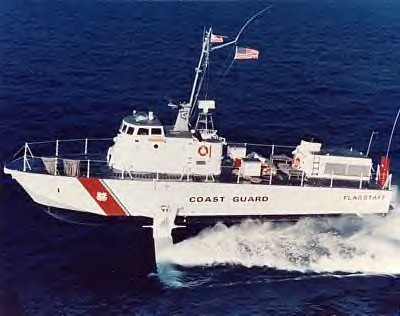Beginning in 1952, the U.S. Navy sponsored a research & development program to construct & evaluate a number of hydrofoil test-craft. As a result of this program, in April 1966, the Navy's Bureau of Ships awarded contracts for two competing hydrofoil gunboats, the PGH-1 to the Grumman Corporation, and the PGH-2 to the Boeing Company. The PGH-1 was completed in March 1968 and christened
Flagstaff in honor of Flagstaff, Arizona. She completed acceptance trials and was delivered to the Navy Amphibious Force Pacific on November 7, 1968. In November 1969,
Flagstaff was transported to South Vietnam and deployed as a patrol craft for river operations out of Danang in Operation Market Time. In 1970, after completing her Vietnam tour, she was returned to San Diego for operations with Boat Support Unit One, Amphibious Forces Pacific.
On November 4, 1974, she was loaned to the U. S. Coast Guard on the West Coast for a period of testing to evaluate the utility of a hydrofoil craft as a Coast Guard cutter. This testing continued until February 1975 when Flagstaff was returned to the Navy.
On September 29, 1976, the Coast Guard again took possession of Flagstaff to enable the Service to do a long-term evaluation in an actual operational environment. The ship was dispatched to Boston, MA where she underwent repairs and cold weather modifications. On March 2, 1977, at the Coast Guard Support Center in Boston, wearing Coast Guard colors, Flagstaff was formally commissioned as the Coast Guard cutter (WPGH-1). Lt. Terrance Hart assumed command of the cutter and her crew of 12 enlisted personnel. On July 17, 1977 she was placed in active status and home-ported in Woods Hole, MA. She operated out of her homeport for a period of 16 months. As part of the Coast Guard Fleet, Flagstaff performed duties of law enforcement, search and rescue operations, and enforcement in the new 200-mile fisheries economic zone.
Flagstaff was decommissioned on September 30, 1978. This decision was based, in part, on the cost of needed repairs and the fact that the Coast Guard felt that sufficient information on the use of hydrofoil craft had been derived from the evaluation program.
Flagstaff and the other Navy R&D hydrofoil ships and craft served to lay a solid technology foundation for the design and deployment of a squadron of six Navy Patrol Hydrofoil Missile (PHM) ships that were later built by Boeing.
 Manufacturer: Grumman
Manufacturer: Grumman
Propulsion hullborne: Two General Motors Diesels with waterjet pumps
Propulsion foilborne: Rolls Royce Tyne gas turbine with super-cavitating propeller
Length: 73 feet
Beam: 21.5 feet
Draft, Foils Retracted: 4 feet, 4 inches
Draft, Foils Extended: 18 feet
Displacement: 69.5 long tons
Design Speed, hullborne: 8 knots
Design Speed, foilborne: 45 knots
Weapons: One 40mm L/60 Bofors, Two twin .50 AN/M-2HB mg, One 81mm mortar Mk 2 Mod 0 (1969-1970); Bofors replaced by 152mm gun/missile launcher (1971)
